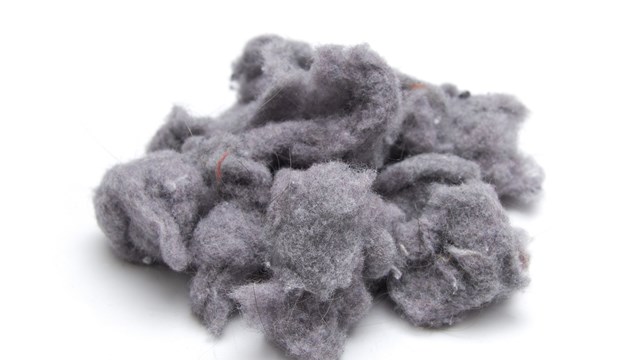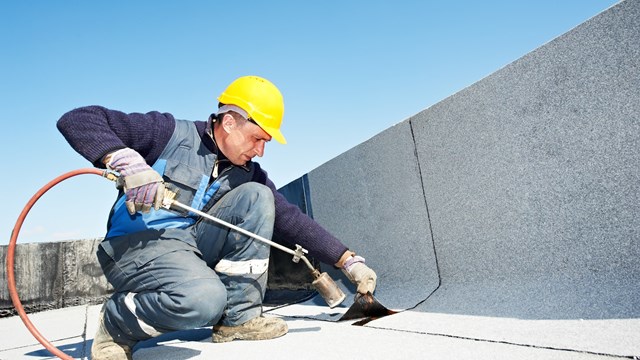
Building owners are charged with the constant battle of keeping water out of the building envelope, but sometimes the water that causes stains, mold and decay comes from within the building envelope. Consideration to design, materials and use must be given during initial construction and reconstruction projects.
Water infiltration into and within the building envelope is a prevalent condition throughout all parts of the world—so much so that the study of water infiltration is a science. Moisture can infiltrate (leak) in liquid form from the exterior into the building envelope or it can be introduced into the building envelope in its invisible vapor form and under the right conditions, condense into water molecules and cause similar havoc to that of a building leak. So what is condensation, why does it occur, and how does one control it?
Condensation is the process of water vapor in the air turning to liquid water. Condensation of water vapor occurs when the temperature of the air is lowered to the point that the air cannot hold any more moisture (the dew point). At this critical temperature, the water vapor will turn to liquid water, until equilibrium between the air temperature and the amount of water vapor that that specific temperature can hold is met.
The task of keeping the habitable space on the interior of a building dry sounds like it should be a relative easy one. Despite this seemingly easy task, there are literally hundreds of books on the subject, the building codes address it, there are lectures on it and there are engineers and contractors that specialize in it. The formula for keeping condensation from forming within a building appears relatively simple at first glance (for an assumed constant pressure): Keep the humidity inside the building envelope at a level below a saturation point for the minimum anticipated temperature in the building. So assuming that the interior environment of the building is typically controlled to 70 degrees Fahrenheit, the interior humidity must be kept below 50 percent.
This seemingly easy task is difficult because there are a number of variables that can affect the amount of water vapor in the air (humidity), as well as the temperature—they are as follows:
Building Construction—The amount of air exchanges through the building envelope is a function of the materials used to construct the building, the quality of the workmanship, the architecture and engineering, including amount and type of fenestration, the air conditioning and ventilation systems, the use and location of vapor barriers and insulation. Newer ‘tight’ buildings require special attention to controlling the humidity levels within the home. So as a builder or designer, what items must be considered to control moisture?
• Vapor drive can come through the soil into the basement
• When a building is constructed the concrete, paint, plaster and other finish materials can give off significant amounts of water as they cure and reach equilibrium.
• The movement of moisture is via one of four mechanisms:
• Through building material by capillary pressure
• By convection of air caused by surface temperature differentials
• By transfer of air under pressure differentials.
• By diffusion through materials under gas pressure.
Water vapor moves due to a difference in water vapor pressure from the high-vapor pressure to the low vapor pressure side of an assembly, ultimately seeking equilibrium.
Water vapor pressure will vary with the temperature of the air.
The geographic location of the building and local weather—Buildings in the Northeast tend to have longer heating seasons and less vapor drive from the exterior, while buildings in the south east have more cooling days and vapor drive tends to be from the exterior—however these are not constants and can vary significantly from hour to hour.
The use of the building—Residential buildings are subject to the creation of a significant amount of water vapor being introduced within the home from the following sources:
• A family of four can add moisture to the air equivalent to 8 to 12 gallons of water per week.
• Showering, cooking, bathing and washing can add 4 to 6 gallons per week.
• Drying clothes indoors can add 3 to 4 gallons per week.
• New construction practices and materials such as curing concrete, curing wall plaster, drying paint, drying floor finishes, etc. contains 6,000 to 9,000 gallons of water.
Further complicating the equation, but of less significance in the diffusion of water vapor through building materials. Water vapor moves due to a difference in water vapor pressure from high-vapor pressure to low-vapor pressure side of a building assembly (i.e. wall or roof). This has a lesser impact and the technical arguments are beyond the scope of this paper, however the model codes generally address the installation of vapor barriers or retarders to address diffusion.
The codes also address the amount of insulation to be used, the use of vapor barriers and vapor retarders. The model building codes address ventilation and moisture control in general terms, however the code requirements vary from location to location. For example, in the Northeast, there are specific requirements for ventilation of crawl spaces and attics, however in Florida, the same code requirement (that is intended to dry out moisture) would introduce hot, humid air. This air could hit colder surfaces such as high-hat light fixtures, pipes or ducts and cause condensation in the attic that could result as a leak into the finished space below.
Condensation will also form on cold surfaces (such as single window panes and aluminum window frames with no thermal break) as warmer moisture saturated air contacts the cold surface, causing the air that is in contact with the window to cool.
Solutions:
As the most basic and general rule, a vapor retarder should be installed on the warm side of the insulation (for the northeast region of the country) during new construction or significant rehab projects. This vapor retarder will limit the amount of interior water vapor that passes into the wall cavity. This is typically accomplished by installing paper faced insulation upon original construction.
As an occupant of a building, steps that can be taken include:
Reduce the amount of moisture in the building:
You can do this by limiting the activities that generate a lot of damp warm air, such as:
• letting saucepans boil without lids
• drying washing clothes indoors
• taking long showers without proper bathroom ventilation
• using clothes dryers that are not properly ducted to the exterior
• keeping humidifiers on when not necessary
• Promote good air circulation in your home:
• Open blinds and drapes so that air can circulate freely over the windows.
• Direct heat towards exterior walls and windows.
Where condensation at window sills is a persistent problem, remove any objects on the window sill such as that may prevent air from circulating and removing the moisture.
Move furniture such as sofas and bookcases so they are not touching outside walls. This will improve air circulation around the cooler outside wall and reduce condensation potential.
Increase Ventilation:
• Make sure there is adequate air circulation in the attic of the home, with a balanced venting condition.
• Direct all fans and vents to the exterior – do not allow fans to terminate in the attic space.
• Perform routine maintenance to ensure that exhaust fans are clear at both the interior (i.e. lint traps) and exterior (vent louvers are clear of bee hives, bird nests, etc.)
• Make sure that crawlspaces are adequately insulated and vented.
• Open a window when cooking or and after bathing to let the moist air escape. Consider having exhaust fans installed over the stove and in bathrooms.
Keep the building warm:
In cold weather, aim to keep a little bit of background heat in all rooms, so that rooms and surfaces do not get very cold.
Make sure that there is adequate insulation in the attic (note that insulation loses its R-value over time).
If high-hat lighting fixtures are installed, make sure that they are properly insulated in the attic so as not to be a source of heat loss in the attic.
In extreme conditions, one may need to modify the existing construction by:
• Moving heating elements to the outside walls or window areas that experience ‘cold’ spots.
• Install dehumidifiers to reduce the amount of interior water vapor.
• Install a source of ‘make-up’ or fresh air from the exterior to the heating unit.
• Replace inefficient windows with new units that contain thermal breaks and insulated glass.
• Install mechanical ventilation units with a humidistat.
In summary, one can see that the use and maintenance of a building by its occupants can have a significant impact on the humidity levels and condensation issues that may occur. Condensation was not much of a problem in pre-WWII construction, as the ‘loose’ or energy inefficient construction allowed for the flow of air and humidity in and out of the building. With new, more efficient construction methods and more appliances and habits that release water vapor into the home, condensation has become more prevalent and the damages and mold growth that go along with continued wetting have become an issue.
Be sure to consider the use of spaces when evaluating building materials and consider controlling the variables such as fresh air, temperature, humidification and dehumidification when the space is in use to control the ill effects of moisture including staining, structural decay and mold.
William Pyznar is a professional engineer and consultant with New Jersey-based Falcon Engineering.






Leave a Comment